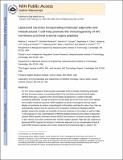Liposomal vaccines incorporating molecular adjuvants and intrastructural T-cell help promote the immunogenicity of HIV membrane-proximal external region peptides
Author(s)
Kim, Mikyung; Reinherz, Ellis L.; Abraham, Wuhbet; Hanson, Melissa Catherine; Liu, Haipeng; Szeto, Gregory; Irvine, Darrell J; Chen, Stephanie H.; Crespo, Monica P.; ... Show more Show less
DownloadIrvine_Liposomal vaccines.pdf (974.9Kb)
PUBLISHER_CC
Publisher with Creative Commons License
Creative Commons Attribution
Terms of use
Metadata
Show full item recordAbstract
An HIV vaccine capable of inducing high and durable levels of broadly neutralizing antibodies has thus far proven elusive. A promising antigen is the membrane-proximal external region (MPER) from gp41, a segment of the viral envelope recognized by a number of broadly neutralizing antibodies. Though an attractive vaccine target due to the linear nature of the epitope and its highly conserved sequence, MPER peptides are poorly immunogenic and may require display on membranes to achieve a physiological conformation matching the native virus. Here we systematically explored how the structure and composition of liposomes displaying MPER peptides impacts the strength and durability of humoral responses to this antigen as well as helper T-cell responses in mice. Administration of MPER peptides anchored to the surface of liposomes induced MPER-specific antibodies whereas MPER administered in oil-based emulsion adjuvants or alum did not, even when combined with Toll-like receptor agonists. High-titer IgG responses to liposomal MPER required the inclusion of molecular adjuvants such as monophosphoryl lipid A. Anti-MPER humoral responses were further enhanced by incorporating high-Tm lipids in the vesicle bilayer and optimizing the MPER density to a mean distance of ∼10–15 nm between peptides on the liposomes' surfaces. Encapsulation of helper epitopes within the vesicles allowed efficient “intrastructural” T-cell help, which promoted IgG responses to MPER while minimizing competing B-cell responses against the helper sequence. These results define several key properties of liposome formulations that promote durable, high-titer antibody responses against MPER peptides, which will be a prerequisite for a successful MPER-targeting vaccine.
Date issued
2015-01Department
Massachusetts Institute of Technology. Department of Biological Engineering; Massachusetts Institute of Technology. Department of Materials Science and Engineering; Ragon Institute of MGH, MIT and Harvard; Koch Institute for Integrative Cancer Research at MITJournal
Vaccine
Publisher
Elsevier
Citation
Hanson, Melissa C., Wuhbet Abraham, Monica P. Crespo, Stephanie H. Chen, Haipeng Liu, Greg Lee Szeto, Mikyung Kim, Ellis L. Reinherz, and Darrell J. Irvine. “Liposomal Vaccines Incorporating Molecular Adjuvants and Intrastructural T-Cell Help Promote the Immunogenicity of HIV Membrane-Proximal External Region Peptides.” Vaccine 33, no. 7 (February 2015): 861–868. © 2014 Elsevier
Version: Author's final manuscript
ISSN
0264-410X